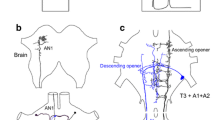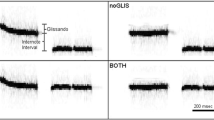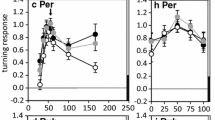Abstract
Female crickets lacking experience with phonotaxis to conspecific calling song respond to trains of continuously repeated sound pulses (trill), whereas experienced females do not. In the present study such inexperienced crickets were tested for their responsiveness to trills of pulse repetition periods from 30 to 70 ms on a Y- shaped maze. Stimulation with a repetition period of 30 ms led to unexpectedly low phonotactic and exploratory activity. Initial stimulation with trills of 30- ms repetition period drastically reduced the responsiveness of inexperienced animals to conspecific calling song and other attractive stimuli. Effects of visual stimulation on the phonotactic behavior of female crickets are demonstrated. Threatening visual stimuli changed the behavior of experienced animals to a state that resembles that of inexperienced animals. The relevance of these observations is discussed with respect to the development of the auditory pattern recognition mechanism in crickets.
Similar content being viewed by others
References
Doherty, J. A. (1985a). Temperature coupling and “trade-off” phenomena in the acoustic communication system of the cricket,Gryllus bimaculatus De Geer (Gryllidae).J. Exp. Biol. 114: 17–35.
Doherty, J. A. (1985b). “Trade-off” phenomena in phonotaxis and calling song recognition in the cricket,Gryllus bimaculatus De Geer (Orthoptera: Gryllidae).J. Comp. Physiol. 156: 787–801.
Doherty, J. A. (1985c). Phonotaxis in the cricket,Gryllus bimaculatus De Geer: Comparisons of choice and no-choice paradigms.J. Comp. Physiol. 157: 279–289.
Elsner, N., and Popov, A. V. (1978). Neuroethology of acoustic communication.Adv. Insect Physiol. 13: 229–335.
Koudele, K., Stout, J. F., and Reichert, D. (1987). Factors which influence female cricket's (Acheta domesticus) phonotactic and sexual responsiveness to males.Physiol. Entomol. 12: 67–80.
McFarland, D. (1985).Animal Behaviour. Psychology, Ethology, Evolution, Pitman, New York.
Murphey, R., and Zaretsky, M. (1972). Orientation to calling song by female crickets,Scapsipedus marginatus (Gryllidae).J. Exp. Biol. 56: 335–352.
Pollack, G. S., and Hoy, R. (1979). Temporal pattern as a cue for species specific calling song recognition in crickets.Science 204: 429–432.
Pollack, G. S., Huber, F. and Weber, T. (1984). Frequency and temporal pattern-dependent phonotaxis in crickets (Teleogryllus oceanicus) during tethered flight and compensated walking.J. Comp. Physiol. 154: 13–26.
Popov, A. V. (1972). Acoustic signals of crickets (Orthoptera. Gryllidae) in southern European parts of the USSR.Entomol. Obozr. 51: 17–36 (in Russian).
Popov, A. V. (1985).Acoustic Behavior and Hearing of Insects, Leningrad (in Russian).
Popov, A. V., and Shuvalov, V. F. (1977). Phonotactic behavior of crickets.J. Comp. Physiol. 119: 111–126.
Popov, A. V., Shuvalov, V. F., Knyazev, A. N., and Klar-Spasovskaya, N. A. (1974). Communication calling songs of crickets (Orthoptera, Gryllidae) from south western Tadjikistan.Rev. Entomol. USSR 53: 258–279 (in Russian).
Sakaluk, S. K. (1982). Onset of phonotaxis and the age of first mating in female house crickets (Acheta domesticus).N.Y. Entomol. Soc. 90: 136–141.
Sergeeva, M., and Popov, A. V. (1987). Ontogenetic changes in negative phonotactis and its neurophysiological correlates in the cricketGryllus bimaculatus.Z. Evolut. Biokhim. Fiziol. 23: 58–67 (in Russian).
Sergeeva, M. V., and Popov, A. V. (1988). Ontogenetic changes in positive phonotaxis in the cricketGryllus bimaculatus.Z. Evolut. Biokhim. Fiziol. 24: 210–216 (in Russian).
Shuvalov, V. F. (1985). Influence of environmental factors on phonotactic specificity in the cricketGryllus bimaculatus during ontogenesis.Z. Evolut. Biokhim. Fiziol. 21: 555–560 (in Russian).
Shuvalov, V. F., and Popov, A. V. (1971). The reaction of females of the domestic cricket (Acheta domesticus) to sound signals and its change in ontogenesis.Z. Evolut. Biokhim. Fiziol. 6: 612–616 (in Russian).
Shuvalov, V. F., and Popov, A. V. (1973). Significance of some of the parameters of the calling songs of male cricketsGryllus bimaculatus for phonotaxis of females.Z. Evolut. Biokhim. Fiziol. 9: 177–182 (in Russian).
Shuvalov, A. V., and Popov, A. V. (1984). Dependence of phonotactic specificity in crickets of the genusGryllus from the character of preliminary sound stimulation.Dokladui Akad. Nauk 274: 1273–1276 (in Russian).
Smith, J. W. (1977). Communication in Birds. In Seboek, T. A. (ed.),How Animals Communicate, Indiana University Press, Bloomington & London.
Stout, J. F., Gerard, G., and Hasso, S. (1976). Sexual responsiveness mediated by the corpora allata and its relationship to phonotaxis in the female cricketAcheta domesticus L.J. Comp. Physiol. 109: 1–9.
Stout, J. F., DeHaan, C. H., and McGhee, R. W. (1983). Attractiveness of the maleAcheta domesticus calling song to females.J. Comp. Physiol. 153: 509–521.
Stout, J. F., Atkins, G., Weber, T., and Huber, F. (1987). The effect of visual input on calling song attractiveness for femaleAcheta domesticus.Physiol. Entomol. 12: 135–140.
Thorson, J., Weber, T., and Huber, F. (1982). Auditory behavior of the cricket. II. Simplicity of calling song recognition inGryllus, and anomalous phonotaxis at abnormal carrier frequencies.J. Comp. Physiol. 146: 361–378.
Tschuch, G. (1977). Der Einfluβ synthetischer Gesänge auf die Weibchen vonGryllus bimaculatus De Geer (Teil 2).Zool. Jahrb. Physiol. 81: 360–372.
Author information
Authors and Affiliations
Rights and permissions
About this article
Cite this article
Shuvalov, V.F., Rüting, T. & Popov, A.V. The influence of auditory and visual experience on the phonotactic behavior of the cricket,Gryllus bimaculatus . J Insect Behav 3, 289–302 (1990). https://doi.org/10.1007/BF01052111
Accepted:
Issue Date:
DOI: https://doi.org/10.1007/BF01052111




